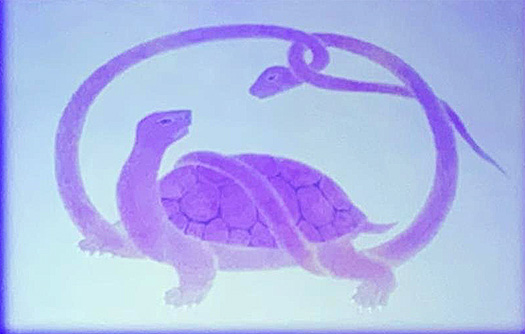



きのうの「四神デザイン」について友人読者のNさんから
とくに「青竜」図とされる表現について違和感が示されていた。
わたしも「イヌかシカか?」という印象を書いた次第ですが、
昭和生まれのわたしたち年代の人間として、これから永く残したい
復元建築の平城宮大極殿を飾る「四神図」としてはいろいろ意見があるところ。
もう一点は「玄武」としての亀とヘビの絡みの図案。
作家の日本画家・上村淳之氏の言としてはまったくの独創だということ。
一方、対比的に示した写真群はやや時代がさかのぼる法隆寺の伎楽面。
「写実的」な彫刻が主流のこの時代の美術作品のなかでは、
その用途から考えてもデフォルメした表現作品だと思える。
復元四神デザインのコンセプトとある程度似つかわしいと思えた次第。
ただ正殿壁画デザインコンセプトたるかと言われれば悩ましい。
復元に当たって、発注者側の方針がどうであったかが問われるところだけれど、
そういう肉声はわれわれには知る手掛かりがない。
結果として、画伯の表現作品が「平成の復元」の思想として残っていく。
当然ながら民主主義の時代であり主権者各人の受け止め方は自由だと思う。
ただ、これが奈良期の建築とデザイン思想の「よすが」として
後世にまで残っていくことも事実。そういう難しさがある。
当事者のみなさんにはさまざまな葛藤もあったに違いない。
奈良平城宮は歴史的には天武−持統天皇期であり、
建築に当たって藤原不比等が事実上の宰相として仕切っていたとされる。
かれは中臣鎌足の次男であり「史〜フミヒト:書記官」という教育を受け
百済からの亡命官僚群から「中華思想」の骨格を学んだとされる。
具体的には田辺史大隅(たなべのふひとおおすみ)の家で養育されたという。
広く彼らが持っていた漢文や儒教・仏教そして建築の知識を受け継いだ。
この時代にあっては最高学府で最新の知見を身に付けた人物。
持統天皇3年(689年)2月に「判事」に任命されたことから頭角を現す。
この平城宮大極殿もそのような知見の元に事業構築されたと推定できる。
従って建築意図としては正調の中華国家施設を日本でも造営できるのだという
目的意識が当然にして想定できる。
その時代背景を勘案すれば「四神」はどのような表現だっただろうか。
とくに青竜、玄武というような想像力の不可欠な神格について
国家そのものとも言える建築装飾選択で、藤原不比等の脳内に
どういうイメージが浮かんだか想像すれば、この復元にやや違和感はある。
しかしやはりこれは「復元」でありマザーの表現手掛かりも
失われていることを思えば、いまのファンタジックでかわいい系の表現も
「平成の復元」としてならば後世に残っていくことも了解できるか。
しかし自由言論の時代、いろいろ考えてみる契機にはなるでしょうね。
English version⬇
Nara Period and Modern Times, “Restoration” of Aesthetics, Exploration of Heijo-kyo, Nara – 21
Restoration” of the prestige architectural interior design from the democratic modern period to the pioneer period of the nation. Especially, it is difficult to find a way to express the products of imagination. …
A reader friend of mine, Mr. N, expressed his discomfort about the “Four Gods Design” of yesterday.
He expressed his discomfort especially with the expression “blue dragon”.
I also wrote about my impression of “a dog or a deer? I also wrote about my impression of the “blue dragon” design.
As a person of our generation born in the Showa period, I would like to leave it for a long time to come.
There are various opinions about the “Four Deities” that adorn the restored Daigoku-den Hall of the Heijo Palace.
Another is the design of a tortoise and snake intertwined as “Genbu” (Genbu).
The artist, Japanese-style painter Uemura Atsuyuki, says that it is completely original.
On the other hand, the contrasting group of photographs shows a Gigaku mask from Horyuji Temple, which dates back to a slightly earlier period.
In this period, when “realistic” sculpture was the norm, these masks are not at all deformed in terms of their intended use.
In terms of its use, it seems to be a deformed work of expression.
It is somewhat similar to the concept of the design of the four restored deities.
However, it is difficult to say whether this is the same as the concept of the mural design for the main hall.
It is a question of what was the policy of the client side for the restoration.
However, we have no clue as to what the client’s policy was in the process of restoration.
As a result, the artist’s expression remains as the idea of “Heisei no Restoration.
Naturally, we live in an era of democracy, and each sovereign person is free to decide how he or she perceives the work.
However, it is a fact that this work will remain as a “means” of architectural and design thought in the Nara period.
It is also a fact that this work will remain as a “means” of architectural and design thought of the Nara period for posterity. Such is the difficulty.
I am sure that the people involved in this project must have faced many conflicts.
Historically, Nara Heijo Palace was built during the Temmu and Jito periods.
Fujiwara no Fuhito is said to have been in charge of the construction as de facto prime minister.
He was the second son of Nakatomi Kamatatsu, and was educated as a “history (fumihito: scribe)” and a “Chinese” from a group of exiled bureaucrats from Baekje.
He is said to have learned the framework of “Chinese thought” from a group of exiled bureaucrats from Baekje.
Specifically, he was brought up in the house of Tanabe Fumihito Osumi (田辺史大隅).
He inherited their extensive knowledge of Chinese literature, Confucianism, Buddhism, and architecture.
He was the most learned man of his time and had the latest knowledge at the highest level of learning.
He distinguished himself when he was appointed as a “judge” in February of the 3rd year of Emperor Jito’s reign (689).
It can be assumed that the Daigoku-den Hall of the Heijo Palace was constructed based on such knowledge.
Therefore, it is natural to assume that the architectural intention was to build an authentic Chinese national facility in Japan.
It is natural to assume that the purpose of the construction was to build an authentic Chinese national facility in Japan.
What kind of expressions were used for the “four deities” in light of the historical background?
Especially, what kind of expression would have been used for the gods Seiryu (Blue Dragon) and Genbu (Xuanwu), whose imaginative power is indispensable to the nation itself?
I wonder what kind of image would have flashed in Fujiwara no Fuhito’s mind when he chose the architectural decoration, which could be called the nation itself.
If we imagine what kind of image came into Fujiwara no Fuhito’s mind when he chose the architectural decoration, which could be said to be the nation itself, this restoration seems somewhat strange.
However, this is still a “restoration,” and the mother’s expression clues have also been lost.
If we consider that the clues to Mother’s expression have been lost, we can understand that the fantastical and cute expressions of the present day
If we think of it as a “Heisei restoration,” we may understand that it will be handed down to future generations.
However, in the age of free speech, it is a good opportunity to think about various things.
Posted on 5月 7th, 2022 by 三木 奎吾
Filed under: 住宅マーケティング, 歴史探訪







コメントを投稿
「※誹謗中傷や、悪意のある書き込み、営利目的などのコメントを防ぐために、投稿された全てのコメントは一時的に保留されますのでご了承ください。」
You must be logged in to post a comment.